Toshiba Satellite U845W Ultrabook Review: Going Wide at 21:9
by Dustin Sklavos on October 16, 2012 12:01 AM ESTOverall Performance
The Ivy Bridge CPU that beats at the heart of the Toshiba Satellite U845W isn't the fastest on the block, but it should certainly be adequate. Using a caching solution instead of a dedicated SSD is bound to hurt PCMark scores, but I did find in practice that it was a healthy step up from just having a straight mechanical hard disk in the system. You can at least feel the difference when using the U845W.
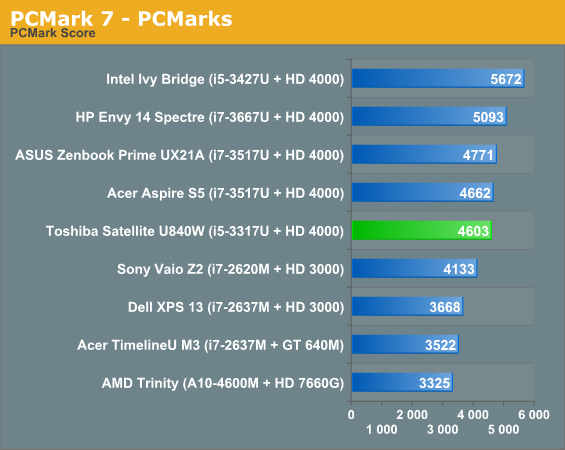
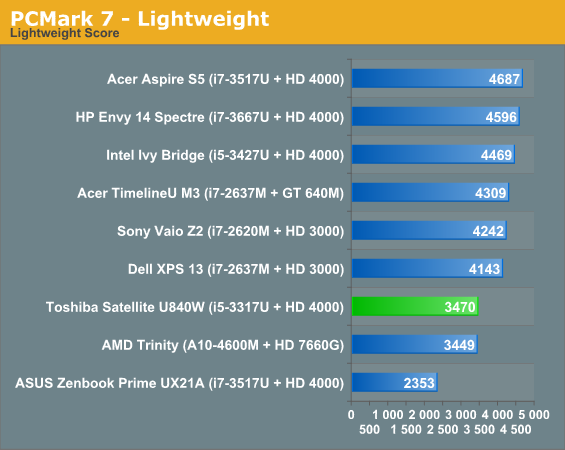
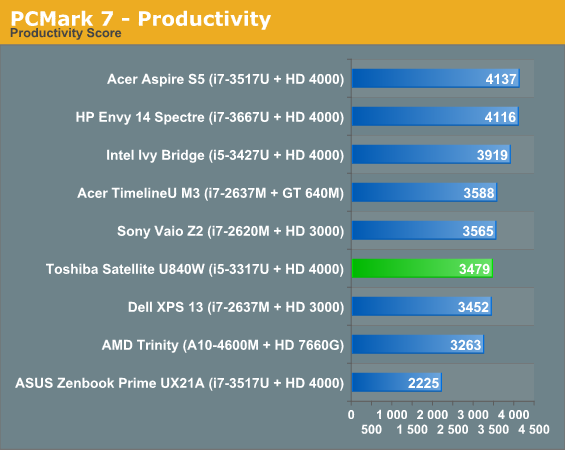
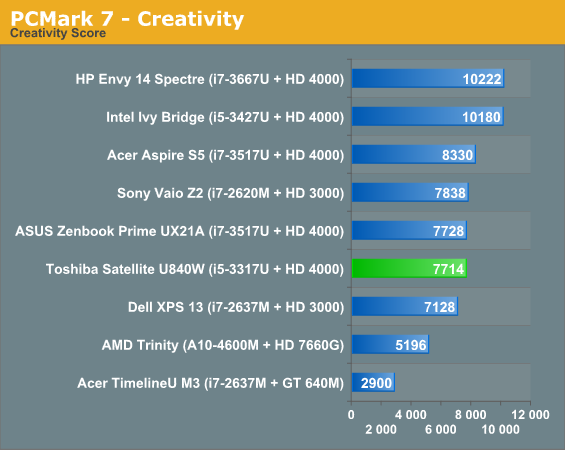
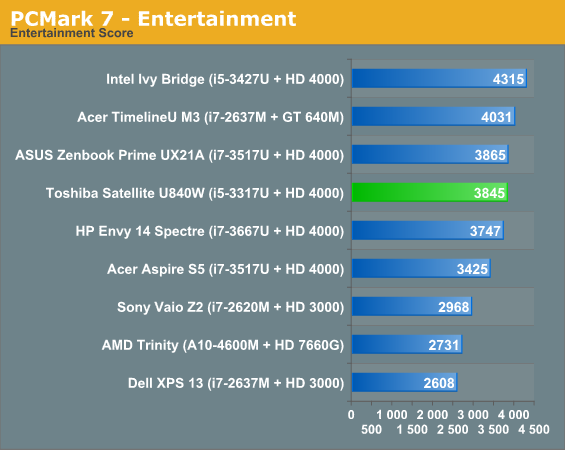
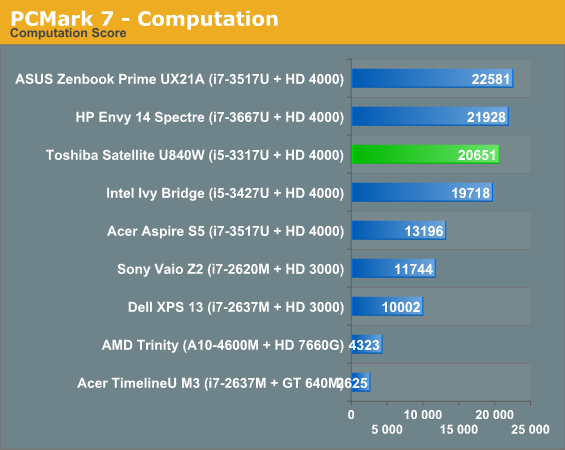
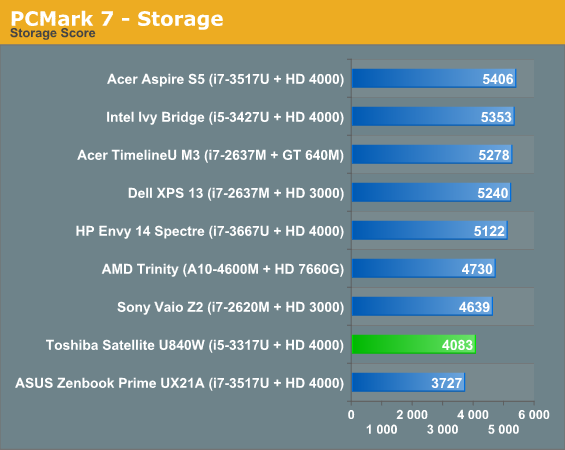
The lack of a dedicated SSD causes the U845W to jump around the charts a bit. PCMark Vantage should hopefully paint a clearer picture.
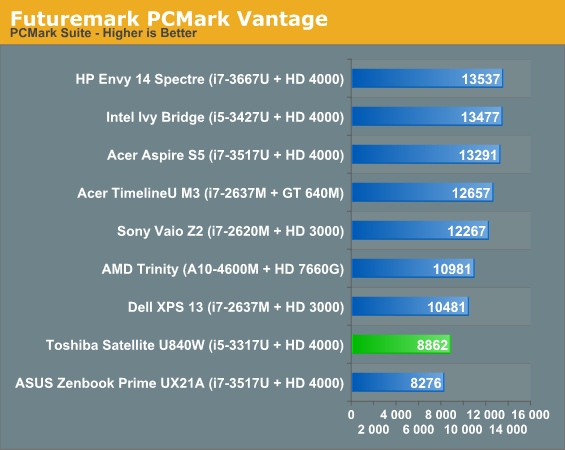
And there it is. Caching helps, but generally a dedicated SSD produces superior performance.
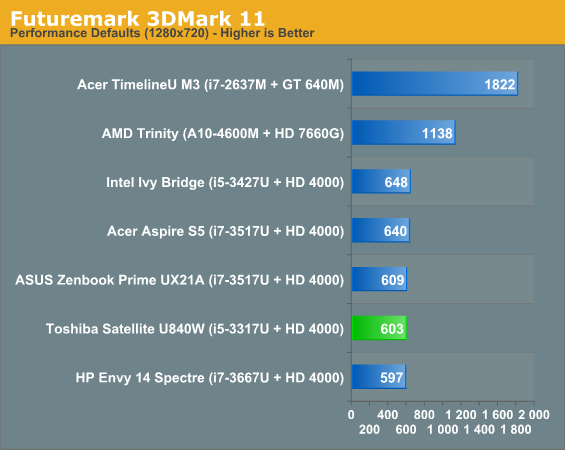
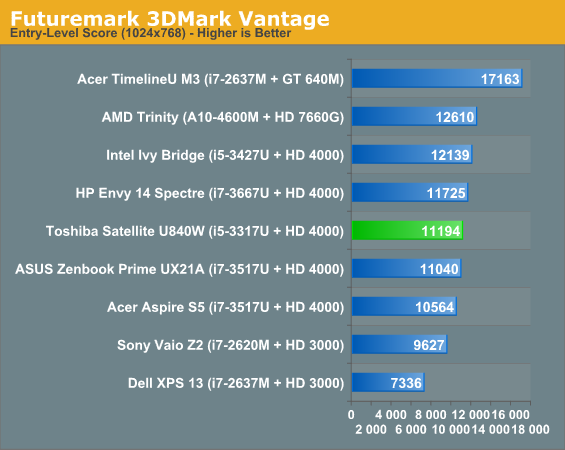

3DMark performance is pretty much where we'd expect it, even a bit better. As you'll see later on, Toshiba's thermal solution for the Satellite U845W is actually a very good one, and that extra thermal headroom is probably allowing the notebook to run in turbo modes for longer than some of the competing designs (as seen in 3DMark06).
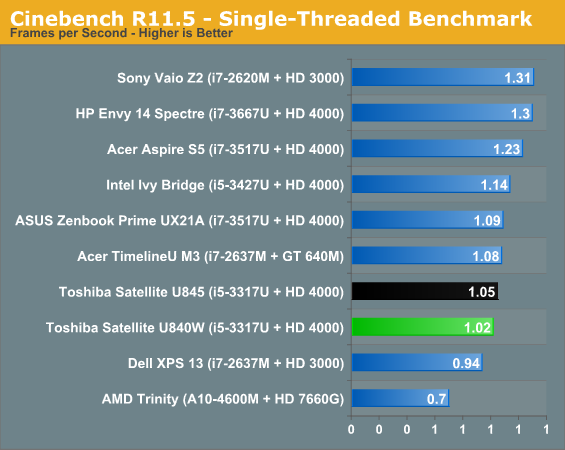
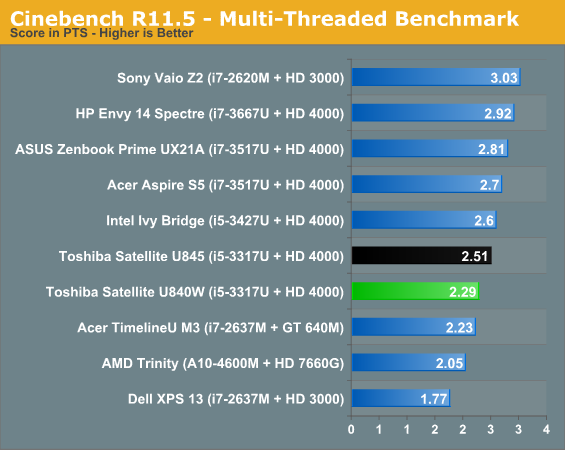
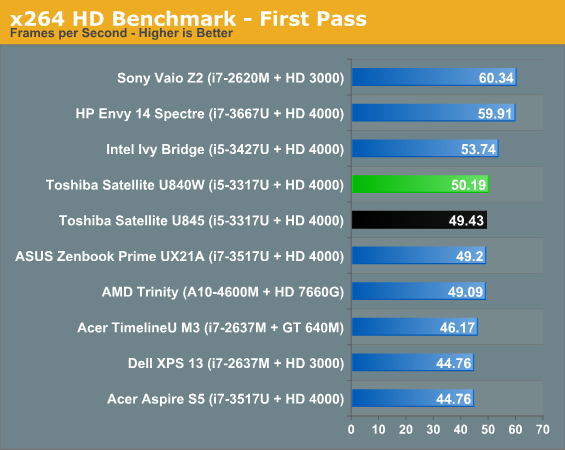
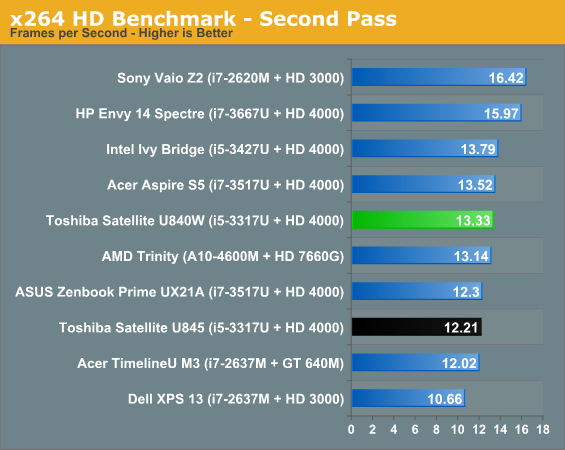
The Satellite U845W and comparable U845 produce fairly consistent scores and are cetainly capable enough notebooks.
While ordinarily I eschew doing gaming benchmarking on HD 4000-equipped systems unless we just don't have enough scores, I'm making an exception with the U845W. The reason is a simple one: the appeal of potentially gaming at a 21:9 resolution. I will say that subjectively games do look really cool on the U845W, and that makes the lack of a dedicated graphics solution a little heartbreaking.
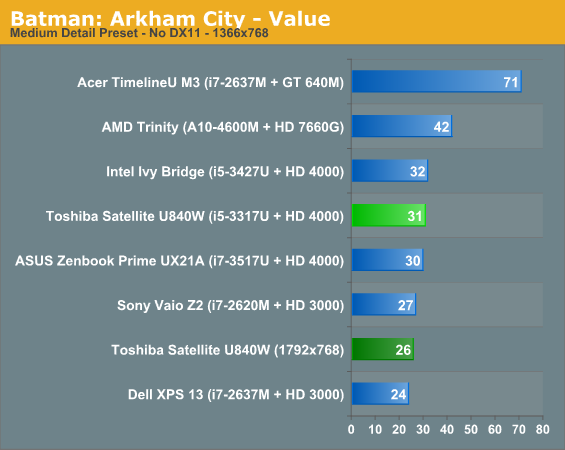
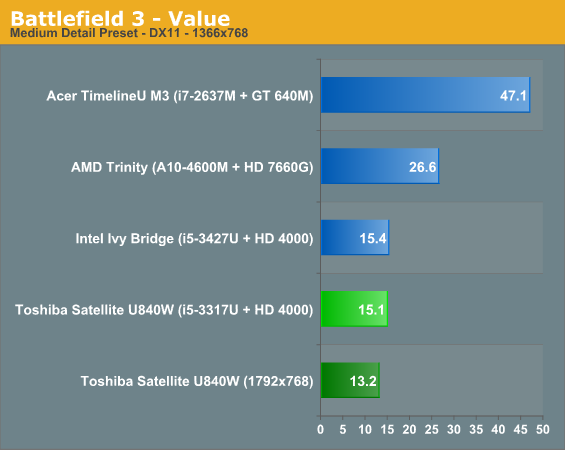
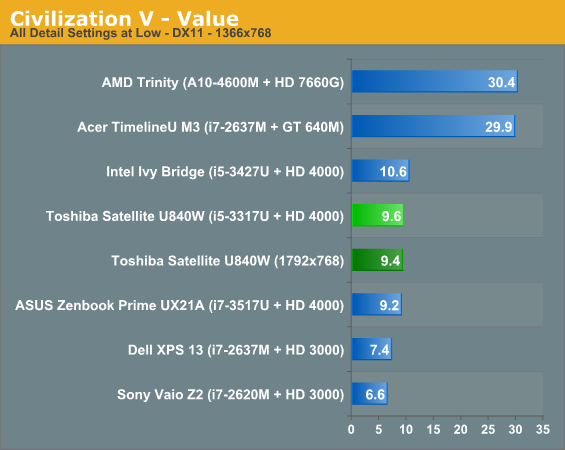
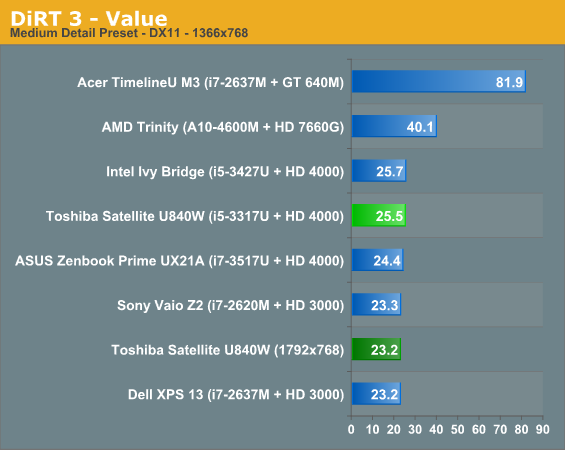
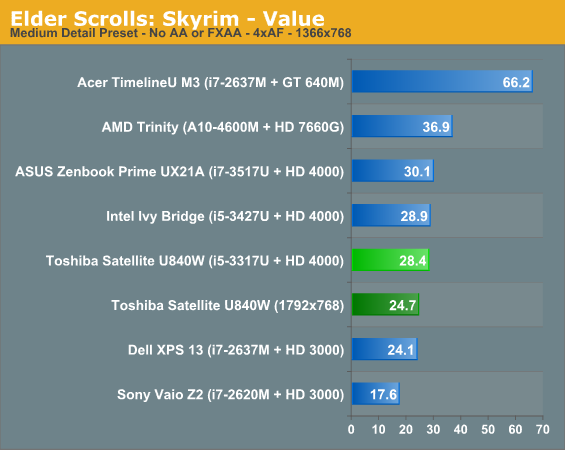
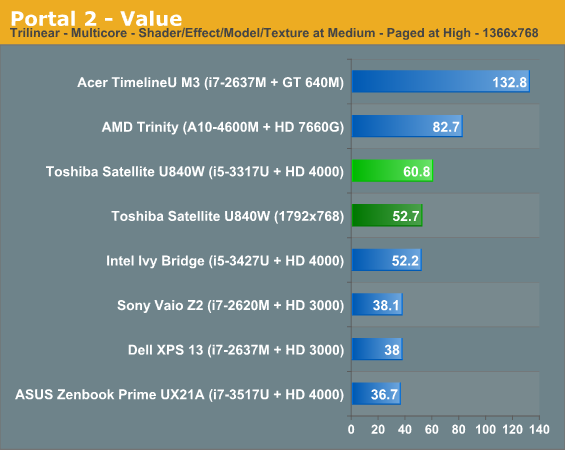
Only Portal 2 offers truly playable performance, but it's worth noting that the increase in resolution doesn't seem to hurt the Ivy Bridge GPU too badly. If you're willing to bring settings even further down, there's a good chance you can make a few of the games here playable. That means the HD 4000 in the U845W will certainly do in a pinch, but I'd love to see Toshiba come out with a model that has even a low end 28nm die-shrunk Fermi in it. Something with just a little more kick than the HD 4000.










57 Comments
View All Comments
kevith - Tuesday, October 16, 2012 - link
No thanks.Belard - Tuesday, October 16, 2012 - link
This is SOOOO Amiga 2000/4000 and Commodore 64.Exodite - Tuesday, October 16, 2012 - link
To be fair though, the Amiga at least ran much better aspect ratios.StevoLincolnite - Tuesday, October 16, 2012 - link
Would have had me on board if:* No TN panel. IPS, anything IPS, even E-IPS or even VA would be better.
* Double the 768 vertical resolution as it is painful regardless of how wide a panel is.
* Decent Graphics (Refuse to use Intel graphics after the last several decades of poor IGP's with even worse drivers which are still crap today.) or went with AMD's trinity.
* Better network connectivity.
As for peoples qualms about the wider aspect, to me it's fantastic but I also game in eyefinity so I'm used to having extra wide screens.
Unfortunately, companies like Toshiba would never bother reading the comments here at Anandtech to see what people want, instead we get the same let-downs from all manufacturers. :(
AssBall - Tuesday, October 16, 2012 - link
I'm sure Toshiba does care about your comments. Considering 0.01% of their customers read Anandtech, and 1% of those feel the same way you do. It's definitely folks like you who who want a $3500 dollar laptop who drive their billion dollar worldwide mobile computing roadmap.Belard - Tuesday, October 16, 2012 - link
Am I missing something here? I really don't see much of a reason for this odd-ball shaped screen, already 16:9 (standard) screens SUCK! 16:10 is better.A more usable resolution in 1920x1080, easily possible on todays 13~14" displays.
You can STILL work on documents side by side WHILE having some height to work with and not get that tunnel vision feeling.
tomeklutel - Tuesday, October 16, 2012 - link
Widescreen laptops just doesn’t make sense. When we spend most of our time working with spreadsheets, text documents, and web browsers, we want a higher resolution with a longer page. Widescreen laptops are actually lower resolution and cheaper to manufacture, so largest companies were convincing that 16:10, then 16:9 is the best format for your eyes. Lot of business people and heavy users still prefer 4:3 screen. Join our community to show your demand for bringing back 4:3 screens to people - https://www.facebook.com/pages/Bring-Back-43-Lapto...Paulman - Tuesday, October 16, 2012 - link
But if you make it WIDE-screen ENOUGH, then all of a sudden you can fit two windows side by side as you work or you can have one big window and still enough screen real estate on the side to have your IM window open, or some video going on the side, or CPU monitor stuff, etc.It may not be the most common use scenario, but for some people they might really get a lot out of it. It sounds pretty interesting and kind of attractive to me (I just tried using two windows side by side on my 16:9 HDTV I use as my main monitor and it works pretty well. I'm typing this comment on the right while a Starcraft 2 live video stream with chat box is going on on the left).
The real killer use-case for this would be when you need to write or edit a document while doing research on the Internet, or working with some crazy-wide Excel spreadsheet, etc. Those kinds of people would be REALLY interested in this kind of ultrabook.
knedle - Tuesday, October 16, 2012 - link
I think that there is one big difference between your scenerio and this netbook.You have HDTV monitor, and this notebook has low resolution monitor, which in fact makes many other things difficult. For example web browsing. Websites aren't wide, they are long in terms of height and imagine how much scrolling it's gonna to be on 768 pixels high monitor.
DanNeely - Tuesday, October 16, 2012 - link
Andrew Cunningham reviewed the U845W for Ars Technica last month. The problem is that most websites (and applications) really want to be at least 1024 wide so it didn't work out that well. H was interested in trying the same thing at 2100x900; which would be wide enough to make side by side generally workable and have a halfway decent vertical resolution as well.http://arstechnica.com/gadgets/2012/09/putting-the...